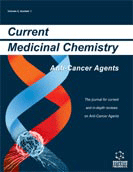Abstract
Multidrug resistance of tumors, characterized by resistance against a variety of chemically unrelated anticancer agents, can be caused by overexpression of ATP-binding cassette (ABC) proteins, such as P-glycoprotein and MRP1. These multidrug-resistance proteins are plasma-membrane proteins that actively extrude chemotherapeutic agents from the cell interior, decreasing drug accumulation and thus, allowing the cells to survive in the presence of toxic levels of anticancer agents. ABC proteins contain multispanning transmembrane domains and nucleotide-binding domains (NBDs). The NBDs are responsible for the ATP binding / hydrolysis that drives drug transport, and their structure is conserved independently of the degree of primary-sequence homology. The transmembrane domains contain the drug-binding sites that are likely located in a flexible internal chamber that is sufficiently large to accommodate different drugs. It has been recently proposed that dimerization of the NBDs induced by ATP binding is a key step for the coupling of ATP hydrolysis to substrate transport. The power stroke for substrate transport can be the formation or the dissociation of the dimers. Since the NBDs and TMDs are tightly associated, association / dissociation of the NBDs may control the “gate” of the translocation pathway, formed by intracellular loops. In the case of P-glycoprotein it seems that the power stroke for transport is ATP binding (and therefore NBD dimerization), and not hydrolysis, because the major conformational and functional changes seem to occur at this step.
Keywords: p-glycoprotein, mdr1, mrp1, abc proteins, atp-binding cassette, nucleotide-binding domain, chemotherapy, anticancer agents
 11
11

















